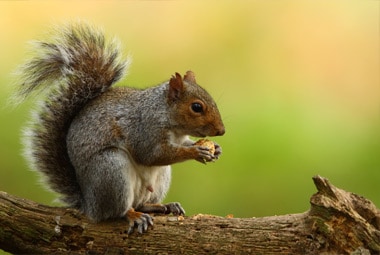
Tree squirrels can be found living throughout Missouri. The two most common species of tree squirrels in Missouri are the fox squirrel and the Eastern gray squirrel. These squirrels are fittingly named “tree squirrels” because they are usually found living in areas where trees are present.
| Pest Identification | |
|---|---|
| Recognition | Tree squirrels are typically whitish gray, yellowish, red or brown in color and their belly is usually lighter in color than the rest of their body. Tree squirrels have a distinctive long bushy tail that they use for balance. The fox squirrel is larger than the Eastern gray squirrel. Fox squirrels grow to be about 10-15 inches in length (not including their tail) and weigh 1 2/3 to 2 1/3 pounds. Eastern gray squirrels are about 8-10 in length (not including their tail) and weigh 1 1/3 to 1 2/3 pounds. |
| Biology | Tree squirrels are able to mate at about one year of age. Females will produce two litters a year. Their first mating period is in late December or early January and the second is from late May to early June. The gestation period is about 42-45 days. The young are born naked, blind, and with ears that are closed. Tree squirrels generally have 3-4 young per litter and at about 4 weeks of age their ears open, then at about 6 weeks eyes their eyes open, and finally at 2-3 months they will wean and leave the nest to start a life on their own. |
| Habits | Tree squirrels typically live in areas where trees are present, but can also be seen leaping from utility line to utility line and from house to house. In the outdoors tree squirrels will nest in the cavities of trees, but they will also come inside homes, especially as the weather cools in the late fall, to nest in chimneys, attics, crawl spaces, and in garages and sheds. Squirrels typically feed on things like fruit, bark, nuts, seeds, buds, bulbs and insects. They will also gather extra food that they store in a hidden area to help feed themselves over the winter months. Tree squirrels are most active in the early morning hours and in the afternoon. Tree squirrels damage your home by chewing through the exterior of it in order to get inside. They will then chew through wires, pipes, insulation, drywall, floors, and damage personal items and contaminate food sources. They also spread their urine and feces throughout your home and introduce diseases to you and your family. |
| Prevention | Preventing squirrels from invading your home and property is a difficult but important task. Making a few easy changes around your property and home will make it less attractive to squirrels and will help to stop them from getting into your home. -Do not purposely feed squirrels and other wildlife on your property. -If you have bird feeders make sure to place them a good distance away from the outside of your home. -Trim back trees, bushes and other landscaping from the exterior of your house. -Inspect your home’s foundation and fix any cracks or large gaps in it. -Make sure there is a tight fitting cap on any chimneys, fix any loose or missing roof shingles, and make sure that vent covers are secure. -Be sure not to leave garage and shed doors open for long periods of time. -Fix any broken windows in your home or outbuildings. |
| Professional | The best way to prevent and control problems with tree squirrels is to partner with a professional pest control company who has the experience and equipment necessary to trap and humanely remove wildlife from your property. At Rottler we can eliminate tree squirrels from your property through our wildlife control program. Our professionals will inspect your home and property and provide you with the best options available to remove tree squirrels from it and make changes to help prevent a re-infestation. |

